I have a subclassed QAbstractTableModel
to display the data in the Table View in full size without scrolling I have turned of the Scrollbars
to get ridd of the white space around the Table View I have set the vertical/horizontal table length to a specific value.

Problem is that
I have added a add/deleate row Method to the Model so the Table View expands/shrinks now
to adjust the Table View behavior to display the data in full size and without white space I have set the horizontal Header to
table_view.horizontalHeader().setStretchLastSection(True)
which cuts off the white space in horicontal direction correctly
the same operation for the vertical header cuts of the white space too but does over strech the last row

I tryed to set each row to a default size with
table_view.verticalHeader().setSectionResizeMode(qtw.QHeaderView.Fixed)
table_view.verticalHeader().setDefaultSectionSize(40)
but this turns the white space on again
In short form: Im looking for a way to display the model data in the Table View in Full Size without white Space while beeing able to deleate/insert a row
code example
#!/usr/bin/env python
"""
"""
import sys
import re
from PyQt5 import QtWidgets as qtw
from PyQt5 import QtCore as qtc
from PyQt5.QtCore import Qt
from PyQt5 import QtGui as qtg
class ViewModel(qtc.QAbstractTableModel):
def __init__(self, input_data=None):
super().__init__()
self.input_data = input_data or [["data","data","data","data"],["data","data","data","data"]]
#
def data(self, index, role): # parameter index, role are needed !
"""
"""
if role == qtc.Qt.DisplayRole:
try:
text = self.input_data[index.row()][index.column()]
except IndexError:
text = None
return text
def rowCount(self, index=qtc.QModelIndex()):
return 0 if index.isValid() else len(self.input_data)
def columnCount(self, index):
return len(self.input_data[0])
def insertRows(self, position, rows, parent=qtc.QModelIndex()):
print(position) # -1
position = (position + self.rowCount()) if position < 0 else position
start = position
end = position + rows - 1
if end <= 8:
self.beginInsertRows(parent, start, end)
self.input_data.append([])
self.endInsertRows()
return True
else:
return False
def removeRows(self, position, rows, parent=qtc.QModelIndex()):
position = (position + self.rowCount()) if position < 0 else position
start = position
end = position + rows - 1
if end >= 1:
self.beginRemoveRows(parent, start, end)
del self.input_data[start:end + 1]
self.endRemoveRows()
return True
else:
return False
def headerData(self, section, orientation, role):
if role == qtc.Qt.DisplayRole:
if orientation == qtc.Qt.Horizontal:
return "hight " + str(section+1) + " /mm"
if orientation == qtc.Qt.Vertical:
return "width " + str(section+1)
def flags(self, index):
return qtc.Qt.ItemIsEditable | qtc.Qt.ItemIsSelectable | qtc.Qt.ItemIsEnabled
def setData(self, index, value, role=qtc.Qt.EditRole):
if role == qtc.Qt.EditRole:
try:
row = index.row()
column = index.column()
pattern = '^[\d]+(?:,[\d]+)?$'
if re.fullmatch(pattern, value, flags=0):
print("true")
self.input_data[row][column] = value # float
else:
print("nope")
pass
return True
except ValueError:
print("not a number")
return False
def display_model_data(self):
print(self.input_data)
class MainWindow(qtw.QWidget):
def __init__(self):
super().__init__()
# geometry
self.setGeometry(900, 360, 700, 800)
# View
table_view = qtw.QTableView()
# done # turn scroll bars off
table_view.setVerticalScrollBarPolicy(Qt.ScrollBarAlwaysOff)
table_view.setHorizontalScrollBarPolicy(Qt.ScrollBarAlwaysOff)
self.model = ViewModel()
table_view.setModel(self.model)
table_view.horizontalHeader().setStretchLastSection(True)
# table_view.verticalHeader().setStretchLastSection(True)
table_view.verticalHeader().setSectionResizeMode(qtw.QHeaderView.Fixed)
table_view.verticalHeader().setDefaultSectionSize(24)
table_view.verticalHeader().setStretchLastSection(True)
# verticalHeader->setSectionResizeMode(QHeaderView::Fixed);
# verticalHeader->setDefaultSectionSize(24);
# widgets
self.insert_row_button = qtw.QPushButton("insert row")
self.deleate_row_button = qtw.QPushButton("deleate row")
# layout
layout = qtw.QVBoxLayout()
layout.addWidget(table_view)
layout.addWidget(self.insert_row_button)
layout.addWidget(self.deleate_row_button)
self.setLayout(layout)
self.show()
# function
self.insert_row_button.clicked.connect(lambda: self.model.insertRows(-1, 1))
self.deleate_row_button.clicked.connect(lambda: self.model.removeRows(-1, 1))
if __name__ == '__main__':
app = qtw.QApplication(sys.argv)
w = MainWindow()
sys.exit(app.exec_())